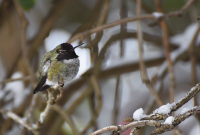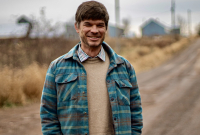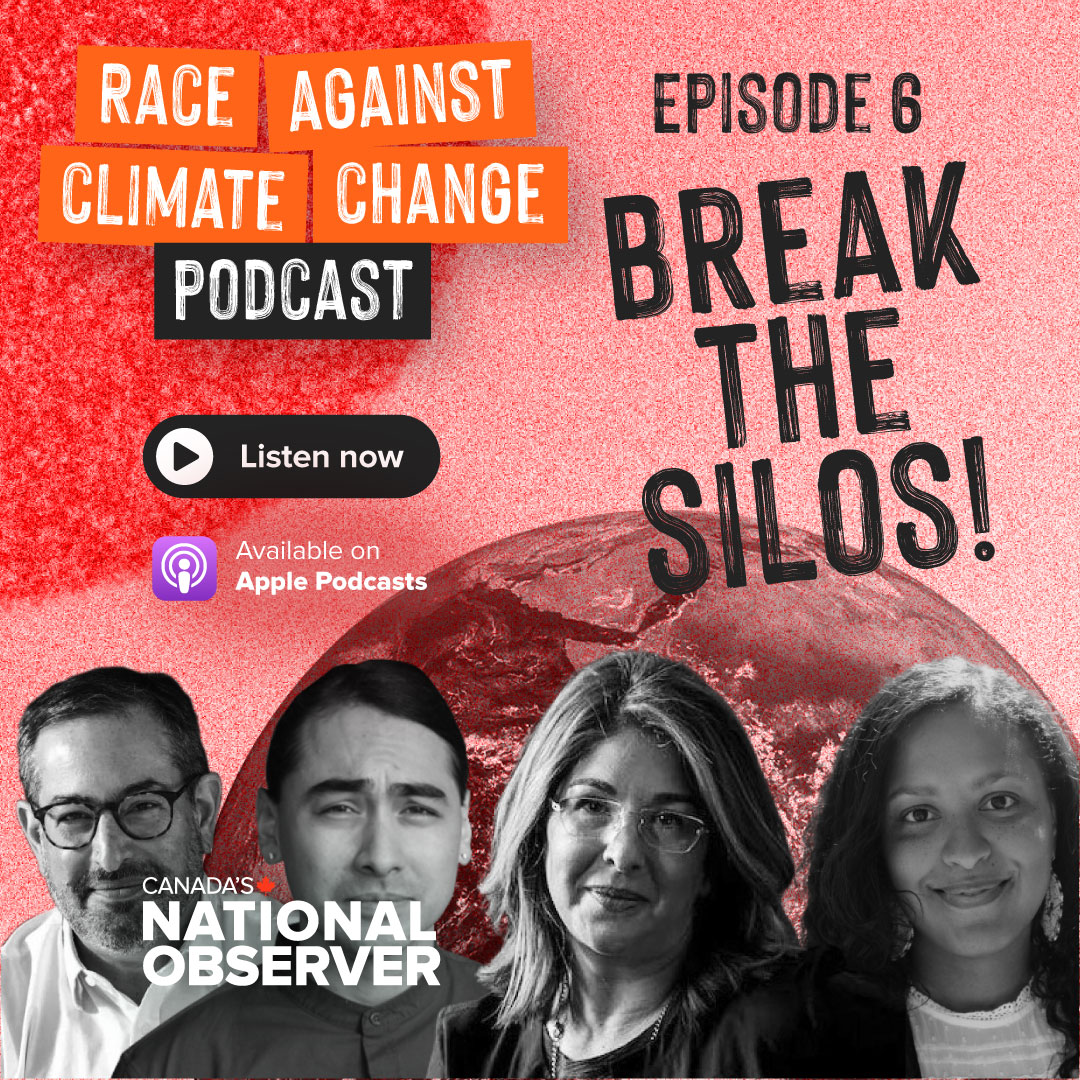Support strong Canadian climate journalism for 2025
This story was originally published by Yale Environment 360 and appears here as part of the Climate Desk collaboration.
A sign hanging above the door of a giant open-top glass chamber in a remote part of Minnesota’s Marcell Experimental Forest explains why so many scientists from around the world have worked hard to get a piece of this boreal woodland. “Welcome to the Future” the sign reads, and that is literally what researchers get when they come to do research at Marcell.
The experiment — a collaboration between the U.S. Forest Service and the Department of Energy’s Oak Ridge National Laboratory — features 10 open-top glass chambers. Each is 30 feet high, 40 feet in diameter, and designed — by controlling temperature and CO2 levels — to mimic what will happen to boreal peatlands under various global warming scenarios. They range from no change to a very realistic increase of 4 F, to 7 F, and even to a frightening 12 F and higher.
The Marcell Experimental Forest was established in 1962 to investigate the ecology and hydrology of the boreal forest, which in North America extends from the Lake Superior area of the northern United States to northern Canada and Alaska. Boreal woodlands — the world’s largest forest system, holding vast carbon-rich peatlands — also cover Scandinavia and much of Russia.
In the past several decades, the research focus at Marcell has shifted to the impacts of global warming on the boreal forest, with more than 50 experiments now underway. The site is just one of numerous long-term study sites where scientists have for decades been researching climatic changes in the boreal. Studies in the Great Lakes area, the permafrost-rich regions of Tanana Flats and the Bonanza Creek Experimental Forest in central Alaska, and the Scotty Creek lowlands of Canada’s Northwest Territories are all tracking the transformation of North America’s boreal ecosystem. Across the region, peatlands are drying out, and hotter, drier conditions are leading to a steady increase in wildfires — all of it accelerating permafrost thaw.

In 2016, scientists first started to pump both heat and carbon dioxide into the chambers at the Marcell forest to see how these and other peatlands would respond to climate warming. Five years on, U.S. Forest Service scientist Randy Kolka; Paul Hanson, an ecosystem scientist at Oak Ridge; and their colleagues are already seeing significant changes, with the warmed plots quickly making the transition from being carbon accumulators to carbon emitters.
The peat at the Marcell forest had stored 15 times more carbon than the recut forests in the eastern United States. But in a recent study, Kolka, Hanson, and other collaborators describe how the chambers are losing carbon 4.5 to 18 times faster than historical rates of accumulation. When dried or degraded, moisture-absorbing peat collapses, losing its ability to store carbon.
As Kolka guided me through a chambered bog that is being heated up at the fastest rate, he pointed out warming-related changes. The tamarack and spruce trees were browning. Heat- and moisture-loving shrubs were so dense that we could hardly see the sphagnum on the bog floor. These and other mosses that are the building blocks of peat, he said, are not going to last.
Peat is partially decayed vegetation that accumulates in the cold, water-logged, oxygen-starved bogs and fens of the boreal. As temperatures warm, the peat dries out in the south and thaws in the North, where trees are drowning and rivers and lakes are browning with solid organic carbon that is dissolving in the water. This is leading to the release of massive amounts of carbon into rivers and lakes and the atmosphere.
Given that peatlands store twice as much carbon as all the world’s forests, climate scientists are closely watching these changes. In addition to mitigating floods, filtering water, and slowing or stopping wildfire, the peat-heavy boreal ecosystem provides nesting sites for one billion to three billion birds that journey north from as far away as Argentina.
“The boreal of Minnesota is going to look more like Kansas in the decades ahead if it’s business as usual with carbon emissions,” says Lee Frelich, the director of the Center for Forest Ecology at the University of Minnesota, who has been tracking changes in the Boundary Waters Canoe Wilderness in northern Minnesota for more than 30 years “There’s nothing wrong with Kansas, but we don’t need another one in Minnesota. We only have three biomes here in Minnesota — boreal, temperate, and grassland. Losing the boreal would be a big loss.”
For Frelich, it’s the trees in his part of the boreal that are showing the most dramatic changes. He is seeing more and more red pines with browning crowns, black spruce and balsam failing to regenerate, and temperate species like maples and oak — as well as grasslands — creeping north. In a recent study, he and other scientists predict that by the end of the century, most of the boreal forest in Minnesota will be gone and that a 180- to 300-mile swath of boreal forest in southern Canada will also be lost.
Many scientists believe that the transformation of the southern boreal would be offset to some extent by a northward migration of trees, such as black and white spruce, lodgepole pine, and aspen and birch. One recent study suggests that this has been happening. Increases in carbon dioxide in the atmosphere might also speed up tree growth in the Far North.
But with warming in the western Arctic accelerating two to three times faster than the rest of the world, scientists say the destructive impacts of climate change in the boreal are expected to far exceed any benefits.
At the Bonanza Creek Long Term Ecological Research (LTER) site near Fairbanks, Alaska, scientists have since 1987 been working to better understand the mechanisms that have made the boreal resilient for thousands of years and now render it so vulnerable to unprecedented warming. One of the key findings is that frequent fires are favouring the regeneration of broad-leafed deciduous trees like aspen and birch over conifers. Summer fires burn the soil’s deep organic layer, which exposes the mineral soils below, aiding the expansion of hardwoods and reducing the insulation of permafrost.
While aspen and birch do store more carbon than conifers, increased warming could mean that the northern boreal suffers the same fate as vast stands in the south that are dying because of drought.
“It’s like a card game,” said Jill Johnstone, one of the researchers at Bonanza Creek and now head of the Northern Plant Ecology Lab in the Yukon. “After a fire, there is a shuffling of the deck. In the boreal, where the ecosystem has very few tree and plant species compared to, say, the Amazon, there are only a certain number of ways that the game can be played out. Controlling forces such as soil acidity, precipitation, heat, and permafrost help determine which plants and trees are most successful. So does climate change, now more than ever before.”
One recent study found that the ability of black spruce — a keystone boreal species — to regenerate declined at 38 per cent of the fire study sites and failed completely at 18 per cent of the sites.
The growing number, extent, and severity of boreal wildfires are accelerating the permafrost thawing that is already well underway. This thawing is uprooting and inundating vast stands of forest from Alaska eastwards into the Yukon and Northwest Territories.
When Torre Jorgenson began his studies in Tanana Flats in the 1990s for the U.S. Army Cold Regions Research and Engineering Laboratory, climate change was not a major concern. Now, however, Jorgenson and others are astonished by the swift changes, especially the flooding of large areas of “drowned” boreal forest.
“In November, I was skating on ice through one of these drowned forests just outside Fairbanks,” said Jorgenson, a past-president of the U.S. Permafrost Association. “It was weird, to say the least, seeing the trunks of these dead trees still standing frozen in ice. It’s going to get worse. We’re predicting that by the end of century we will lose another 36 per cent of permafrost and there will be very few trees left in the [boreal] lowlands.”
Disturbance is nothing new to the boreal. It’s what makes it resilient. In the past 12,500 years, flooding from melting glaciers and snowpack transitioned this icy world from aquatic forbs to mosses and shrubs. Then, as water levels decreased and the land drained and dried out, trees such as black spruce and aspen grew on top of thick layers of peat.
But just as extensive summer sea ice melt in the Arctic Ocean is leading to far less winter sea ice formation, warmer winters in the boreal are no longer allowing the ground to refreeze and stem the loss of permafrost. The watery fens in Tanana Flats are expanding exponentially. According to a recent study by Jorgenson and his colleagues, the size of three large fens in Tanana increased by 26 per cent from 1949 to 2018.
Similar flooding in the Liard and Mackenzie valleys to the southeast in Canada’s Northwest Territories is a big concern for the Indigenous people who rely on fishing, hunting, and trapping to make a living. “Moose and caribou are moving to drier places,” according to Dieter Cazon, manager of Lands and Resources for the Liildii Kue First Nation. “Beavers and muskrats are disappearing, and it’s getting difficult to get to one place from another with so much water on the land. We’re also seeing riverbanks collapsing.”
William Quinton is a University of Waterloo hydrologist who has been studying permafrost in this region since 1999. Based at the Scotty Creek Research Station in Canada’s Northwest Territories, Quinton and his colleagues work hand-in-hand with the Liildii Kue Got’ine people, whose traditional ecological knowledge is augmenting the science that is being done on the ground. Their long-term memory of the past and their knowledge of how fish and wildlife are responding to climate change animate the data that Quinton and his colleagues are collecting.
“It’s tough to be a tree in this landscape,” says Quinton, whose research station at Scotty Creek sits in the middle of a 59-square-mile swath of the boreal forest that has a high concentration of wetlands. “There has been so much flooding that we have had to move our base camp twice. Some trees are hanging on, sitting on top of hummocks that act like lifeboats. But as the trees grow, the weight of them collapses the hummocks below.”
Winters at Scotty Creek, according to Quinton, are warming faster than summers. In the 1950s, permafrost covered nearly three-quarters of the region. It’s down to a third of that. The edges of local patches of permafrost are receding by about a metre a year, leaving behind depressions that fill up with melting snow and ever-expanding groundwater channels.
“What we’re seeing, perhaps more clearly than any other place in the world, is ecosystem change occurring in fast motion,” says Quinton.
Another concern linked to the swamping is the “brownification” of lakes, rivers, and streams that comes as solid organic carbon in rapidly thawing peat dissolves in the water. When harmless inorganic mercury from the thaw attaches itself to carbon, according to a number of studies, microorganisms can convert it to the highly toxic inorganic form of methylmercury.
A major question now is whether thawing of permafrost in boreal peatlands ecosystems will be a slow-moving phenomenon that gradually releases greenhouse gases or a “carbon bomb” about to unload huge stores of carbon. Either way, the transformation of the boreal has implications not only for climate change but for water quality and wildlife habitat and for wildfires that are projected to burn bigger and at shorter intervals — all making boreal regeneration difficult.
The University of Minnesota’s Frelich isn’t giving up hope for the boreal. Like Torre Jorgenson, he suspects that some parts of the boreal in the cooler, undeveloped highlands and those adjacent to cold lakes will survive, just as patches of boreal forests in the Sweetgrass Hills of Montana and Moose Mountain in Saskatchewan have done. These boreal refugia could be managed to control wildfire, invasive species, and human developments.
“The challenge,” says Frelich, “is determining where these refugia are most likely to be. Then we can put conservation measures in place to protect them. Outside of reducing carbon emissions, it’s our best hope. Forests die quickly, but trees take a long time to grow.”





Comments